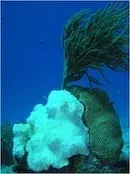 The NOAA Coral Reef Watch (CRW) satellite coral bleaching monitoring shows sea surface temperatures (SSTs) continue to remain above average throughout the wider Caribbean region. Large areas of the southeastern Caribbean Sea are experiencing thermal stress capable of causing coral bleaching. The western Gulf of Mexico and the southern portion of the Bahamas have also experienced significant bleaching thermal stress. The CRW Coral Bleaching Thermal Stress Outlook indicates that the high stress should continue to develop in the southern and southeast Caribbean until mid-October. Bleaching stress in the western Gulf of Mexico and southern Bahamas should dissipate quickly in the next couple of weeks.
The NOAA Coral Reef Watch (CRW) satellite coral bleaching monitoring shows sea surface temperatures (SSTs) continue to remain above average throughout the wider Caribbean region. Large areas of the southeastern Caribbean Sea are experiencing thermal stress capable of causing coral bleaching. The western Gulf of Mexico and the southern portion of the Bahamas have also experienced significant bleaching thermal stress. The CRW Coral Bleaching Thermal Stress Outlook indicates that the high stress should continue to develop in the southern and southeast Caribbean until mid-October. Bleaching stress in the western Gulf of Mexico and southern Bahamas should dissipate quickly in the next couple of weeks.
Analysis and Outlook for Caribbean, Gulf of Mexico and Bahamas
Current conditions:
The CRW satellite monitoring shows that thermal stress levels capable of causing belaching have continued to develop in the southeastern Caribbean since July, bearing a similar signature to the thermal stress observed at the same time period in 2005, the year of a record mass coral bleaching event. The highest thermal stress currently spans the entire Lesser Antilles, from Montserrat to Tobago. Lower levels of stress extend westward across the northern coast of Venezuela, and high stress is also found on the Caribbean coast of Panama and Costa Rica. he bleaching stresses in the western Gulf of Mexico and southern Bahamas are still lingering. Earlier stress in Florida, northern Bahamas, and the Greater Antilles has eased, partly due to recent tropical weather. Hurricane Earl left a clear track of cooler water north of the region including reports of cool water at depth in the US Virgin Islands, and other weather disturbances have cooled temperatures from Texas to the Virgin Islands. Mixing and cooling from a hurricane can reduce thermal stress to a reef and prevent severe bleaching. Bleaching has been reported in Tobago to the south and mild bleaching in the US Virgin Islands to the north.
Bleaching outlook:
The CRW Coral Bleaching Thermal Stress Outlook continues to indicate a high potential for thermal stress capable of causing significant coral bleaching in the southern Caribbean in 2010. The region at greatest risk fills the region east from Nicaragua past the island of Hispaniola to Puerto Rico and the Lesser Antilles, and south along the Caribbean coasts of Panama and South America. The intensity of the potential thermal stress is predicted to increase through October. The Caribbean typically experiences elevated temperature during the second year of an El Niño event, with the 2009-2010 El Niño ending in May 2010. The region described here as having the highest potential to experience bleaching-levels of thermal stress is the same region that has been anomalously warm throughout 2010. The model is only slightly over-predicting the strength of the current thermal stress, adding to our confidence that this may be a severe bleaching event.
The full outlook can be found at http://coralreefwatch.noaa.gov/satellite/bleachingoutlook/outlook_messages/bleachingoutlook_20100907_for_2010sepdec.html#webinar